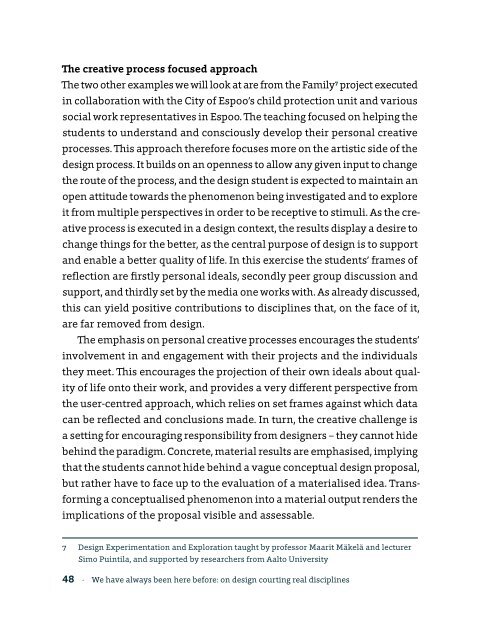Designing for wellbeing
Designing for wellbeing
Designing for wellbeing
Create successful ePaper yourself
Turn your PDF publications into a flip-book with our unique Google optimized e-Paper software.
The creative process focused approach<br />
The two other examples we will look at are from the Family 7 project executed<br />
in collaboration with the City of Espoo’s child protection unit and various<br />
social work representatives in Espoo. The teaching focused on helping the<br />
students to understand and consciously develop their personal creative<br />
processes. This approach there<strong>for</strong>e focuses more on the artistic side of the<br />
design process. It builds on an openness to allow any given input to change<br />
the route of the process, and the design student is expected to maintain an<br />
open attitude towards the phenomenon being investigated and to explore<br />
it from multiple perspectives in order to be receptive to stimuli. As the creative<br />
process is executed in a design context, the results display a desire to<br />
change things <strong>for</strong> the better, as the central purpose of design is to support<br />
and enable a better quality of life. In this exercise the students’ frames of<br />
reflection are firstly personal ideals, secondly peer group discussion and<br />
support, and thirdly set by the media one works with. As already discussed,<br />
this can yield positive contributions to disciplines that, on the face of it,<br />
are far removed from design.<br />
The emphasis on personal creative processes encourages the students’<br />
involvement in and engagement with their projects and the individuals<br />
they meet. This encourages the projection of their own ideals about quality<br />
of life onto their work, and provides a very different perspective from<br />
the user-centred approach, which relies on set frames against which data<br />
can be reflected and conclusions made. In turn, the creative challenge is<br />
a setting <strong>for</strong> encouraging responsibility from designers – they cannot hide<br />
behind the paradigm. Concrete, material results are emphasised, implying<br />
that the students cannot hide behind a vague conceptual design proposal,<br />
but rather have to face up to the evaluation of a materialised idea. Trans<strong>for</strong>ming<br />
a conceptualised phenomenon into a material output renders the<br />
implications of the proposal visible and assessable.<br />
7 Design Experimentation and Exploration taught by professor Maarit Mäkelä and lecturer<br />
Simo Puintila, and supported by researchers from Aalto University<br />
48 · We have always been here be<strong>for</strong>e: on design courting real disciplines
















